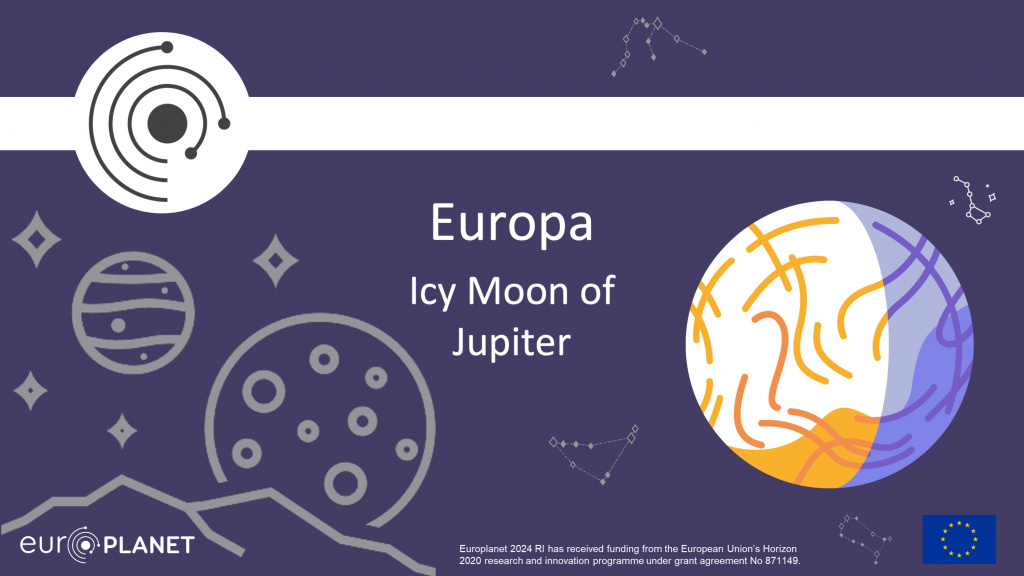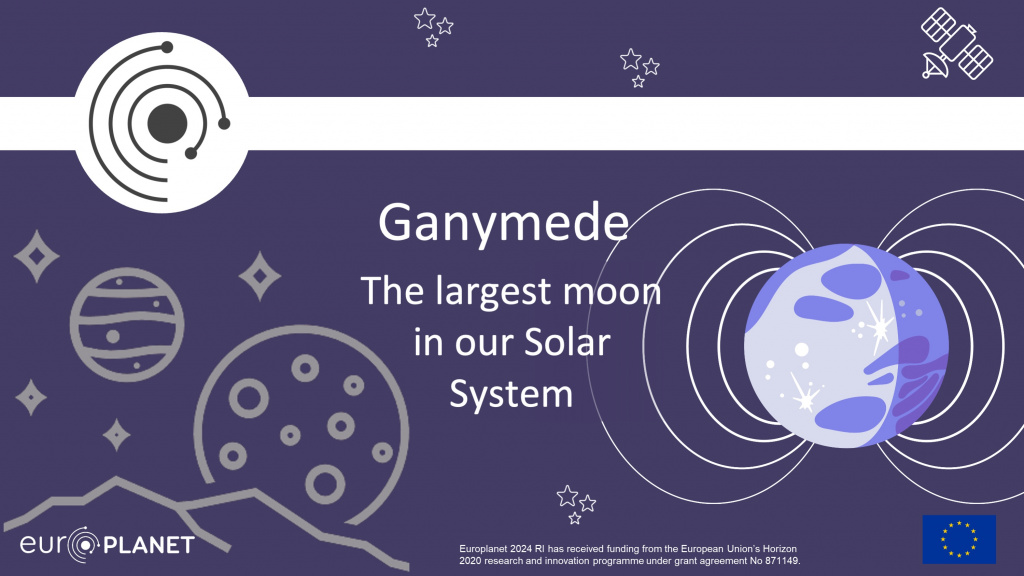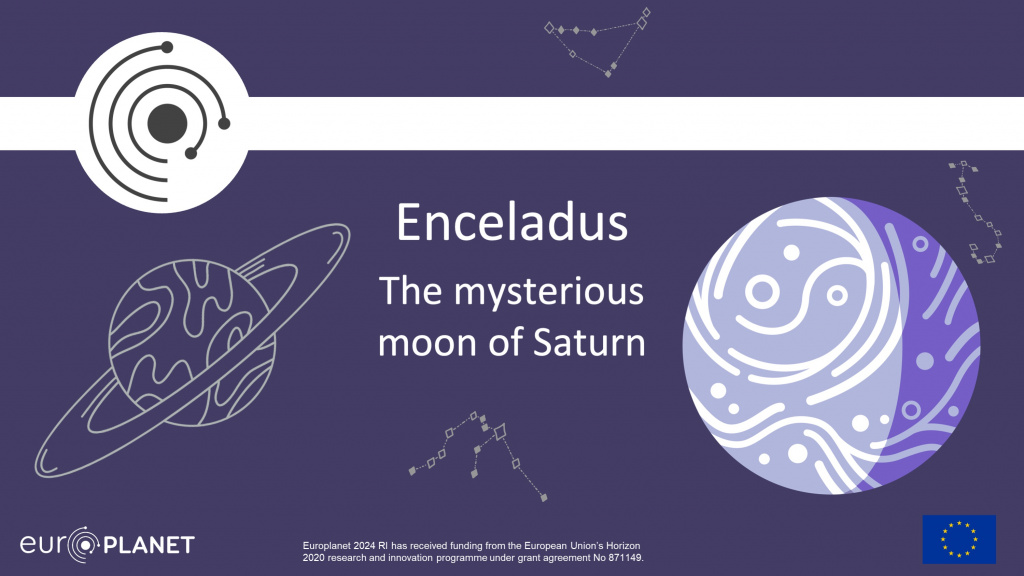Educational Resources – The Icy Moons Collection
As the JUICE mission sets off on its journey to explore the moons of Jupiter, Europlanet has produced a set of school resources to find out more about icy worlds in our Solar System and their potential for life.
Using the resources
- Find out how you can use this resources in more details here.
- The resources are free, adaptable, and we are working to make them accessible to everyone.
- If you repost or share, we just ask that you use the following credit (required by the European Commission, who enabled us to create the resources): ‘The development of these resources has been supported by Europlanet 2024 RI with funding from the European Union’s Horizon 2020 research and innovation programme under grant agreement No 871149.‘
- If you have comments, ideas, questions about the resources we share here, please ask them using the contact form, and we will do our best to answer you.
If you have used our resources, tag us on social media or use the contact form and let us know! We always love to see educators and science communicators share our passion for planetary sciences!
Resources



Presentations
Teachers’ Notes
Europlanet 2024 RI Distributed Planetary Laboratory Facilities
The resources are linked to seven state-of-the-art laboratory facilities that may be used to simulate conditions relevant to icy moons. Europlanet provides funding for scientists and engineers to visit these facilities and carry out research projects.
Aarhus University Planetary Environment Facility, Denmark
(See Resource 1. Europa and Resource 3. Enceladus)
Enceladus, an icy moon of Saturn, has a thin atmosphere that comes from water-vapour plumes emanating from its south pole. Europa, which orbits Jupiter, may also have water-vapour plumes on its surface, contributing to its very thin atmosphere. The Enceladus plumes result in icy material and aerosols becoming distributed across the moon’s surface, and similar processes may be happening on Europa.
To study wind driven transport of ice and dust aerosols, the Planetary Environment Facility at Aarhus University, Denmark, uses a low pressure wind tunnel that can operate at very low temperatures. This has been used to replicate conditions on Mars and Earth, and may simulate the thin atmospheres found on many of the icy moons of our Solar System. Investigating how ice grains and aerosols are transported could help in determining how material from plumes, like those found on Enceladus and Europa, is distributed across icy moon surfaces.
University of Kent Light Gas Gun Laboratory, UK
(See Resource 2. Ganymede)
Many planetary bodies in our Solar System are covered with impact craters. For example, Ganymede’s surface is heavily cratered, and lakes on Titan’s surface may have started as impact craters. On a smaller scale, ice and dust grains in Saturn’s rings may act as micrometeoroids, constantly impacting the icy moons.
The Light Gas Gun at the University of Kent, UK, can simulate impact processes on icy moons by firing projectiles up to 7.5 km s-1. Targets are placed in a large vacuum chamber and may be cooled to temperatures relevant to the surfaces of icy moons. Projectiles of different sizes can be used to simulate processes such as heavy impact cratering, as seen on Ganymede’s surface, and even micrometeoroid impacts, which is happening within Saturn’s rings.
Cold Surfaces Spectroscopy Facility at the Institut de Planétologie et d’Astrophysique de Grenoble (IPAG), France
(See Resource 4. Titan)
Robotic space missions study the compositions and geophysical features of the surfaces of planets, moons, comets and asteroids. For example, the Huygens probe, which landed on the surface of Titan, carried instrumentation to study Saturn’s largest moon’s atmosphere and surface, showing evidence for water ice and complex organic molecules (called tholins).
Icy moon surface analogues may be analysed at the Cold Surfaces Spectroscopy facility at the Institut de Planétologie et d’Astrophysique de Grenoble (UGA/CNRS) in France. This houses two custom-built instruments, SHINE and SHADOWS, that measure properties of various planetary materials. The instruments can work with cryogenic environmental cells to cool down to 213 degrees Celsius under controlled atmosphere or vacuum pressures. These temperatures are relevant to all the known icy moon surfaces in our Solar System.
TA2 Facility 11 – Ice Chamber for Astrophysics / Astrochemistry, Atomki, Hungary
(See Resource 2. Ganymede)
The Ice Chamber for Astrophysics/Astrochemistry at HUN-REN Atomki in Hungary simulates the effect of electrically-charged particles on ices. This is set up to grow interstellar and Solar System ices, which can be cooled to temperatures of -253 degrees Celsius under vacuum conditions. A particle accelerator produces ions which replicate cosmic rays and the stellar wind. This is most relevant to the icy moons of Jupiter, where ions from the Jovian magnetosphere constantly irradiate the surfaces of its moons.
Jupiter’s magnetosphere is one of the largest known structures in our Solar System. The Jupiter’s moons are constantly irradiated by charged particles, which can modify their icy surfaces. There is evidence for radiation driving chemical reactions on the surfaces of Ganymede and Europa. Ganymede is also the only moon in the Solar System to have its own magnetic field, which causes auroras at its poles, much like here on Earth.
TA2 Facility 12 – Atomki ECRIS Laboratory: Atomki-Queen’s University Ice Laboratory for Astrochemistry (AQUILA), Hungary
(See Resource 3. Enceladus and Resource 4. Titan)
Irradiation processes on icy moons may also be simulated used the Atomki-Queen’s University Ice Laboratory for Astrochemistry (AQUILA) at HUN-REN Atomki in Hungary. The facility can produce beams of ions relevant to the solar wind and the environment around Saturn and Jupiter to simulate their effects on icy moons.
Both Enceladus and Titan orbit within Saturn’s magnetosphere, which contains trapped charged particles (electrons, protons, and water-group ions) with a wide energy range. The AQUILA chamber has the capabilities to grow ices relevant to the icy moons and irradiate them with ions found in the magnetospheres of their host planets. Resources 3 and 4 contain details of Saturn’s icy moons, Enceladus and Titan.
TA2 Facility 23 – Open University Flow Through Chambers, UK
(See Resource 1. Europa and Resource 3. Enceladus)
On Earth, hydrothermal vents support ecosystems where a diversity of life thrives. Enceladus is, therefore, very interesting to astrobiologists because there appears to be evidence hydrothermal activity beneath its surface. On the ocean floor, the rocky material reacts with hot ocean fluids, forming complex chemistry that might possibly support life. It is also possible that this is happening on Europa, where heat in the interior is generated through tidal forces from Jupiter’s massive graviational field. The JUICE mission and Europa Clipper will be investigating these processes on Jupiter’s icy moons.
The Open University Flow Through Chambers at the Open University in Milton Keynes, UK, are state-of-the-art facilities that can be used to simulate pressures and temperatures for surface and sub-surface environments of Europa and Enceladus. Fluid can flow through the chamber while scientists are carrying out their experiments, making them an open system that is more realistic to natural environments. The facility can create conditions over a wide range of temperatures from cold to very hot (-10°C to 150°C) and pressures from vacuum to high pressures (0 bar to 300 bar). These chambers are suitable for investigating reactions between water and seabed rocks, as well as reactions between water, rocks and the atmosphere. Experiments to grow microbes under conditions found in these oceans can also be carried out.
TA2 Facility 25 – Swedish Planetary Ices Laboratory, Lulea University of Technology, Sweden
(See Resource 1. Europa and Resource 5. Triton)
The surfaces of icy moons in the Solar System are quite different from each other. The surface of Triton, an icy moon of Neptune, has smooth volcanic plains, with mounds formed by icy lava flows. Around Jupiter, regions of criss-crossed ridges in Europa’s surface form bumpy ‘chaos’ terrain. The shape and texture of the icy moons’ surfaces are key to understanding their evolutionary history and how material is transported and altered on their surfaces. It may also be useful in working out what instrumentation may be needed for future space missions.
The Swedish Planetary Ices Laboratory at Lulea University of Technology, Sweden, uses a thermal vacuum chamber to achieve very low pressures (down to 10-5 mbar – a one-hundred-thousandth of air pressure at sea level on Earth) and temperatures (as low as -140°C), which can be used to carry out experiments relevant to conditions on icy moons such as Triton and Europa. Water and carbon dioxide ices of different formations and textures can be produced and analysed. A spectrometer instrument can be used to analyse the ice at ultraviolet and visible wavelengths. Although this set-up has been used to investigate temperature-driven processes on Earth, Mars, comets and asteroids, conditions relevant to icy moons may also be simulated here. Resources 1 and 5 include more details about Europa and Triton.
Back to Educational Resources

